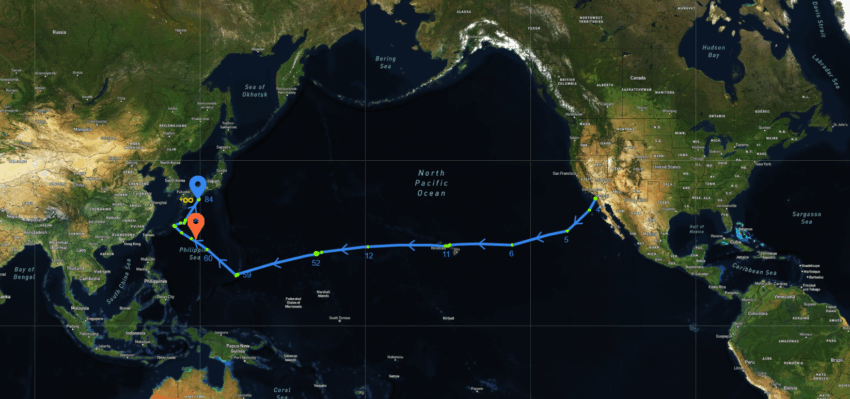WASHINGTON — The autonomous surface vessel producer Seasats had an unexpected encounter with a Chinese warship while transiting the Indo-Pacific earlier this year, its chief executive exclusively told Breaking Defense.
The California-based company conducted a publicly tracked transit of one of its USVs, dubbed Lightfish, from San Diego to Japan, a roughly 7,500 nautical mile trip that took six months from start to finish.
While operating approximately 330 miles northwest of Guam in June, the USV came within meters of the Chinese destroyer Nanchang, according to CEO Mike Flanigan as well as imagery taken by the USV and provided to Breaking Defense.
“It’s pretty common to pass within five or 10 miles of a tanker — in the middle of ocean, there’s really not much traffic going on,” he said. But “for 20 minutes, we basically were shadowed by a Chinese destroyer very closely.”
The Chinese ship “approached” the USV, but as a matter of safety, the Lightfish was broadcasting its position “loudly” through the Automatic Identification System (AIS), the international tracking system used by oceangoing ships to monitor their locations and prevent collisions, according to the company. The USV did not trigger any of its warnings that indicate tampering or interference, but the drone did report that it spotted another vessel — and the company had only discovered the interaction occurred after the fact.
Although the Chinese warship did not interfere with the Lightfish, Flanigan said the whole encounter raised broader questions about how crews at sea approach autonomous drones given the proliferation of unmanned surface vessels attacking larger ships with explosives onboard in the Black Sea and the Middle East.
“You’ve got a [Russian] ship with a handful of sailors on it dealing with a remotely controlled or autonomous [drone], but there’s just no Ukrainian personnel at all on that vessel,” he said of videos depicting crews in the Black Sea fending off drone attacks. “Look at what just happened with us in the middle of the Pacific. We have a $250,000 USV coming within meters of a $900 million Chinese destroyer with close to 100 sailors on it. … Their risk posture is just insanely skewed with these autonomous robots.”
Lightfish, a 12-foot-long, fiberglass drone, is Seasats’s major publicly available product designed for data collection for both commercial and defense purposes. The company has previously worked with the US Navy and Marine Corps, including during the Baltic Operations 2025 exercise conducted earlier this year.
The incident also echoes an encounter by USV maker Saildrone, who had two of its own drones briefly abducted by Iranian paramilitary forces in 2022 while operating in the Middle East. In both instances, the drones were ultimately recovered by the US Navy, which was experimenting with them as part of Task Force 59.
While both Saildrone and Seasats were conducting otherwise innocuous missions during their respective encounters with foreign entities, the question of how a US Navy drone, possibly armed or holding classified technologies, would act in the same circumstance has become a pervasive topic as the service heavily leans into unmanned technologies.
Analysts have previously told Breaking Defense the issue is a two-sided sword: On one hand, protecting its most valuable drones wouldn’t be a huge lift if they operate within the proximity of a carrier strike group. On the other hand, requiring a drone to stay close to its respective strike group severely limits the potential and practicality of it not having sailors aboard.
Click this link for the original source of this article.
Author: Justin Katz
This content is courtesy of, and owned and copyrighted by, https://breakingdefense.com and its author. This content is made available by use of the public RSS feed offered by the host site and is used for educational purposes only. If you are the author or represent the host site and would like this content removed now and in the future, please contact USSANews.com using the email address in the Contact page found in the website menu.








